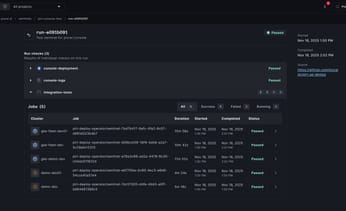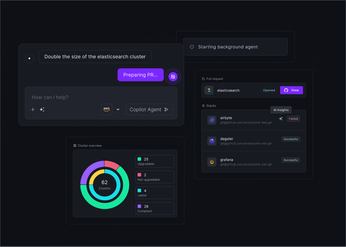
How to Deploy to Multiple K8s Clusters at Scale
Learn how to deploy to multiple k8s clusters at once with proven strategies, unified tools, and best practices for scalable, secure Kubernetes fleet management.
Handling dozens of kubeconfig files, manually configuring RBAC, and SSHing into nodes to debug across environments quickly becomes unmanageable. As your Kubernetes footprint grows, these ad-hoc workflows introduce security risks, drift, and operational inconsistency.
Platform teams need a way to deploy and manage workloads across multiple clusters without losing visibility or control. The solution lies in a unified, automated management model—one that applies GitOps principles, consolidates observability, and uses a secure control plane to provide a single view of the entire fleet.
In this post, we’ll break down the foundational components, best practices, and tooling needed to scale multi-cluster operations with confidence—using Plural as the backbone of this approach.
Unified Cloud Orchestration for Kubernetes
Manage Kubernetes at scale through a single, enterprise-ready platform.
Key takeaways:
- Treat your fleet as a single system: A multi-cluster architecture requires a strategic shift from managing individual clusters to orchestrating a unified fleet. Proactively plan for high availability, consistent security policies, and global traffic management to build a resilient and scalable foundation.
- Automate configuration with GitOps and IaC: Manual configuration across multiple clusters leads to drift and errors. Use Git as the single source of truth for both application deployments (GitOps) and infrastructure provisioning (IaC) to ensure consistency, auditability, and repeatability across your entire environment.
- Centralize control and observability: Managing a distributed environment with fragmented tools is unsustainable. A unified platform like Plural provides a single pane of glass for deploying applications, troubleshooting issues, and enforcing security policies, giving you a consistent operational workflow for your entire fleet.
What Is a Multi-Cluster Kubernetes Deployment?
A multi-cluster Kubernetes deployment runs applications across two or more Kubernetes clusters instead of concentrating all workloads in a single one. Each cluster operates independently but is managed as part of a coordinated system. This requires specialized tooling to handle deployment, routing, and policy enforcement consistently across environments.
A well-architected multi-cluster setup enhances reliability, performance, and security. By distributing workloads, you can isolate failures, reduce latency, and comply with regional or provider-specific requirements. Clusters may span data centers, availability zones, or cloud providers, enabling flexible and resilient infrastructure. The challenge lies in managing this distributed complexity—making a unified fleet management platform essential. Moving to a multi-cluster model shifts the focus from managing individual clusters to orchestrating an interconnected ecosystem, where workloads are placed strategically based on business or technical needs.
Why Go Multi-Cluster?
The primary reason for adopting a multi-cluster architecture is resilience. If one cluster experiences downtime or misconfiguration, traffic can seamlessly fail over to another, eliminating single points of failure. Multi-cluster environments also improve security and stability by isolating workloads—dedicating clusters to specific environments, teams, or tenants. Additionally, by deploying clusters closer to users, teams can significantly reduce latency and improve application performance on a global scale.
Common Use Cases and Scenarios
A few practical patterns drive multi-cluster adoption:
- Environment isolation – Separate clusters for development, staging, and production prevent experimental changes from impacting live systems.
- Multi-tenancy – SaaS providers often allocate distinct clusters per tenant to guarantee data isolation, performance, and compliance.
- Geo-distribution – Global organizations deploy clusters across regions to minimize latency and meet data sovereignty regulations.
In each of these scenarios, a coordinated management strategy—supported by tools like Plural—ensures that scaling across multiple clusters doesn’t come at the cost of control or consistency.
Preparing for Multi-Cluster Management
Managing a fleet of Kubernetes clusters effectively requires a strong foundation built on three pillars: access control, networking, and resource planning. Addressing these early prevents operational friction, security risks, and scalability issues later. A well-prepared foundation ensures your clusters can scale seamlessly while maintaining consistency and control.
Set Up Access and Authentication
Manually maintaining kubeconfigs and RBAC rules for multiple clusters doesn’t scale. Centralizing authentication is essential for both security and efficiency. Plural’s embedded Kubernetes dashboard offers unified, identity-aware access through direct OIDC integration, enabling true single sign-on (SSO). RBAC policies automatically map to user emails and group memberships, so you can define access controls once and apply them consistently across all clusters. This removes the need for repetitive credential management while ensuring least-privilege access across the organization.
Configure Network Requirements
Networking becomes one of the biggest challenges in multi-cluster setups—especially when enabling secure communication across private environments. Plural simplifies this with an agent-based design that uses one-way egress connections from each workload cluster to the management plane. This approach avoids exposing API servers or managing complex ingress rules, making it ideal for private VPCs or on-prem deployments. It provides centralized visibility and control while maintaining a strong network security posture—without the need for multi-cloud networking workarounds.
Plan for Resources and Capacity
Efficient resource planning keeps multi-cluster environments predictable and cost-effective. Using Infrastructure as Code (IaC) ensures that clusters and supporting resources are provisioned consistently. Plural Stacks offers a declarative, API-driven framework that integrates with Terraform to automate infrastructure provisioning and lifecycle management. This centralization helps enforce configuration standards, optimize capacity allocation, and streamline scaling decisions—all from a single management console.
By establishing these fundamentals upfront, you create a scalable, secure baseline for managing Kubernetes at scale with Plural.
Choosing the Right Tools for Multi-Cluster Deployments
Operating multiple Kubernetes clusters demands a toolchain that enforces consistency, automates deployments, and scales reliably. Manual scripting or ad-hoc processes quickly lead to drift, failed rollouts, and security exposure. The goal is to create an integrated workflow that brings together GitOps, configuration management, CI/CD automation, and secrets management—ensuring a uniform and secure operational model across every cluster.
GitOps Solutions
GitOps provides the foundation for scalable, auditable multi-cluster management. By storing all infrastructure and application definitions in Git, you create a single source of truth for your desired state. Automated reconciliation ensures clusters always match the configurations defined in the repository, enabling consistent, version-controlled deployments that are easy to roll back.
Argo CD and Flux are popular open-source GitOps controllers that continuously monitor Git for changes and apply them to clusters using a secure, pull-based model. For enterprise-grade environments, Plural CD extends this approach with a secure, agent-based architecture that supports any deployment environment—without requiring inbound network access to clusters. This simplifies scaling GitOps workflows across private, hybrid, and multi-cloud infrastructures.
Configuration Management Tools
While GitOps manages state synchronization, configuration management tools define what that state looks like. Helm and Kustomize remain the industry standards for templating and overlay management. Helm packages applications into reusable charts with configurable values, while Kustomize allows teams to maintain a base YAML and apply environment-specific patches without using templates.
These tools eliminate redundant YAML files and simplify environment promotion workflows. With Plural, you can seamlessly integrate existing Helm charts or Kustomize overlays into a unified GitOps pipeline—ensuring consistent deployments across every cluster in your fleet.
CI/CD Pipeline Integration
Integrating GitOps into your CI/CD pipelines automates the full delivery lifecycle. After a developer commits code, a CI job builds and publishes a container image, then updates the corresponding Git repository manifest—typically by changing a Helm values file or image tag. The GitOps controller detects this change and deploys it automatically.
This pattern removes manual deployment steps and enforces a consistent, traceable release flow. Tools like Argo CD and FluxCD integrate tightly with CI systems such as GitHub Actions, GitLab CI, or Jenkins, allowing seamless multi-cluster rollouts triggered directly from your development pipeline.
Secret Management Strategies
Secrets such as API tokens, database credentials, and TLS certificates require strict handling—especially in multi-cluster environments. Storing secrets directly in Git, even in encrypted form, increases exposure risk. Instead, use centralized secret management systems like HashiCorp Vault or AWS Secrets Manager, which provide secure storage, fine-grained access control, and auditing capabilities.
These tools integrate with Kubernetes via the Secrets Store CSI driver, injecting secrets into pods as files or environment variables at runtime. This keeps sensitive information out of manifests and Git repositories while maintaining a consistent, automated method for secret delivery across all clusters.
By combining GitOps workflows, robust configuration management, integrated CI/CD, and centralized secret handling—ideally unified under a platform like Plural—you can achieve scalable, secure, and reliable multi-cluster operations.
Exploring Deployment Patterns and Architectures
Selecting the right deployment architecture is critical to building a scalable and reliable multi-cluster Kubernetes strategy. The architecture you choose affects application availability, latency, operational overhead, and cost. There’s no universal pattern—your decision should align with organizational priorities such as uptime guarantees, global reach, or compliance with data residency regulations.
Each deployment model carries trade-offs. Active-active architectures deliver superior resilience but are complex to maintain. Active-passive designs simplify operations but extend recovery times during failover. Multi-cloud deployments mitigate vendor lock-in but require strong governance and consistent configuration management. Platforms like Plural offer a unified control plane that simplifies managing these architectures, enabling consistent policy enforcement and observability across all environments.
Active-Active vs. Active-Passive Setups
The first architectural choice is between high availability (HA) and disaster recovery (DR) models.
- Active-active architectures keep multiple clusters online simultaneously, distributing workloads evenly. If one cluster fails, others automatically handle traffic with minimal downtime—ideal for mission-critical applications that demand continuous availability.
- Active-passive setups maintain a primary cluster for production traffic and a standby cluster for DR. While simpler and more cost-effective, failover introduces temporary downtime as workloads shift.
Plural’s centralized management layer streamlines configuration and monitoring for both models, ensuring fast failovers and consistent state across clusters.
Geographic Distribution Strategies
Distributing clusters geographically improves performance and regulatory compliance. Clusters located near end users reduce latency and enhance responsiveness, while regional placement helps meet data sovereignty mandates—for instance, storing EU user data within the EU.
Maintaining uniformity across distributed clusters requires declarative automation. A GitOps-based workflow ensures consistent application deployments and security policies across regions, allowing teams to scale globally without introducing configuration drift.
Hybrid and Multi-Cloud Configurations
Hybrid-cloud environments span on-premises data centers and public clouds, while multi-cloud setups operate across multiple cloud providers such as AWS, Azure, and GCP. These architectures enhance flexibility, reduce dependency on any one vendor, and allow organizations to take advantage of specialized services.
However, managing clusters across disparate platforms introduces complexity due to differing APIs, IAM models, and networking configurations. A unified management layer like Plural abstracts these differences with Infrastructure-as-Code (IaC) and declarative provisioning, ensuring consistent deployments and governance across all environments.
Resource Allocation Methods
Resource allocation determines how workloads are organized and isolated across clusters.
- By environment: Separate clusters for development, staging, and production to prevent experimental workloads from affecting production stability.
- By team or application: Dedicate clusters to business units or applications for autonomy and resource isolation.
Using IaC and centralized configuration management ensures these allocations are consistent and enforceable. With Plural, you can define quotas, limits, and policies once and propagate them across the fleet—maintaining predictable performance, security, and cost efficiency.
Together, these deployment patterns form the foundation of a robust multi-cluster strategy. When combined with Plural’s unified control plane, they enable organizations to scale Kubernetes operations globally while preserving consistency, compliance, and control.
How to Secure Your Multi-Cluster Deployment
Managing security across a fleet of Kubernetes clusters introduces significant complexity. Each cluster adds to the potential attack surface, and inconsistencies in configuration can create vulnerabilities. A comprehensive security strategy for a multi-cluster environment must address everything from the control plane and network traffic to user access and disaster recovery. The goal is to establish a consistent security posture across all clusters, ensuring that your deployments are not only protected from threats but are also resilient and compliant. This involves a multi-layered approach that starts with the core of Kubernetes itself and extends to your operational practices.
Secure the Control Plane
The control plane is the brain of your Kubernetes cluster, and securing it is your first priority. A compromised control plane gives an attacker full control. Securing it involves hardening each component and ensuring all communication is encrypted. This means configuring TLS for the API server, etcd, and other components. You also need to ensure high availability to prevent outages from becoming security incidents.
Plural’s architecture provides a strong security foundation by design. We use a separate management cluster to orchestrate your fleet, and each workload cluster runs a lightweight agent. This agent initiates all communication with the management plane via a secure, egress-only channel. This pull-based model means you never have to expose your clusters’ API servers to the internet or deal with complex ingress firewall rules, drastically reducing the attack surface.
Manage Authentication and Access Control
In a multi-cluster environment, managing who can do what becomes a major challenge. Without a centralized system, you're left juggling kubeconfigs and manually applying RBAC policies, which is a recipe for misconfiguration. The principle of least privilege should be your guide: grant users and services only the permissions they absolutely need.
A GitOps workflow is essential for managing configurations centrally. By defining RBAC policies in Git, you create a single source of truth that can be applied consistently across every cluster. Plural simplifies this with an embedded Kubernetes dashboard that integrates with your OIDC provider for a true SSO experience. You can configure RBAC policies that map your identity provider's users and groups to Kubernetes roles. This allows you to define a policy once—for example, granting the cluster-admin role to your SRE group—and use a Global Service to sync it across your entire fleet.
Implement Network Security
Network security in a multi-cluster setup is about controlling traffic flow both within and between your clusters. Default Kubernetes networking is often too permissive, allowing any pod to communicate with any other pod. Implementing network policies is critical to segment workloads and restrict communication to only what is necessary. This helps contain the blast radius if a single service is compromised.
For traffic between clusters, especially in hybrid or multi-cloud scenarios, you need to ensure data is encrypted in transit using technologies like VPNs or a service mesh. Networking issues can quickly lead to performance and availability problems if not managed correctly. Plural’s agent-based architecture again simplifies this. The secure gRPC channel used by the agent for all communication means you don't need to set up complex and costly multi-cloud networking. This model ensures secure, reliable communication without exposing your clusters to unnecessary risk.
Plan for Disaster Recovery
A solid disaster recovery (DR) plan is non-negotiable. It’s not just about backups; it’s about your ability to restore service quickly and reliably. Your DR strategy should include regular, automated backups of etcd and any persistent data. More importantly, you need a repeatable process for rebuilding your infrastructure and applications from scratch.
This is where Infrastructure as Code (IaC) and centralized configuration management are invaluable. By defining your entire environment in code using tools like Terraform and storing your application manifests in Git, you create a blueprint for recovery. Plural Stacks provides an API-driven framework for managing Terraform, allowing you to automate infrastructure provisioning as part of your DR workflow. Combined with our GitOps engine for application deployment, you can ensure consistent and efficient operations and recover from an outage by simply pointing Plural to your Git repositories.
How to Manage Traffic and Service Communication
Managing traffic flow and service communication across clusters is one of the most complex aspects of multi-cluster Kubernetes operations. A single user request might reach any cluster in your fleet, and backend services could span multiple regions or clouds. To ensure reliability, low latency, and seamless failover, you need a traffic management strategy that goes beyond simple DNS routing. It must include intelligent load balancing, service discovery, and secure inter-cluster communication. Without these controls, outages and degraded performance become difficult to diagnose and even harder to prevent.
Load Balance Across Clusters
Global load balancing forms the backbone of a resilient multi-cluster architecture. A global load balancer—such as AWS Global Accelerator, Cloudflare Load Balancer, or Google Cloud Load Balancing—routes traffic based on geographic proximity, latency, or custom weighting rules. These rules can prioritize nearby clusters to reduce latency or shift load to less busy clusters for optimal utilization.
Failover policies are equally critical. If a cluster becomes unhealthy, global DNS or load balancing automatically reroutes traffic to healthy regions. When debugging, always verify whether an outage originates from the application layer or misconfigured load balancing. Proper setup ensures no single cluster becomes a bottleneck and users experience uninterrupted availability.
Implement a Service Mesh
As services scale across clusters, communication between them must remain secure and predictable. A service mesh—like Istio, Linkerd, or Consul—provides an abstraction layer that manages service-to-service traffic independently of your application code.
In multi-cluster deployments, a service mesh offers key advantages:
- Traffic management: Intelligent routing, canary rollouts, and retries across clusters.
- Security: Automatic mTLS encryption for all inter-service communication.
- Observability: Fine-grained metrics, tracing, and logging for cross-cluster requests.
By decoupling communication logic from application code, a mesh simplifies networking while improving reliability and insight across distributed workloads.
Enable Cross-Cluster Communication
For services and meshes to operate effectively, you need underlying network connectivity between clusters. This can be achieved through mechanisms like VPC peering, VPN tunnels, or multi-cluster CNI plugins that extend pod networking across clusters.
Plural’s agent-based architecture simplifies this setup by establishing secure, egress-only channels between clusters and the control plane. This design removes the need for inbound network access or exposed API servers, maintaining strong security while enabling centralized observability and management—even across multiple clouds.
Configure Health Checks
Effective traffic management relies on accurate health data. Health checks inform load balancers and service meshes about which clusters or services are healthy enough to receive requests. Kubernetes provides built-in probes:
- Liveness probes verify if containers should be restarted.
- Readiness probes determine if a pod can receive traffic.
- Startup probes delay checks until initialization completes.
In a multi-cluster setup, these signals must feed into a global health view. If one cluster’s workloads begin failing readiness checks, the global load balancer or service mesh automatically removes it from rotation. This continuous feedback loop ensures users are always directed to healthy, performant endpoints.
By combining these mechanisms—global load balancing, a robust service mesh, secure cross-cluster networking, and intelligent health checks—you can build a fault-tolerant, globally distributed Kubernetes architecture managed efficiently through Plural.
How to Monitor and Troubleshoot at Scale
When you're managing applications across multiple Kubernetes clusters, monitoring and troubleshooting become exponentially more complex. An issue in one cluster can cascade and affect services in another, making it difficult to pinpoint the root cause without a clear, system-wide view. Effective troubleshooting at scale requires moving beyond cluster-specific tools and adopting a holistic strategy that provides visibility across your entire fleet. This means centralizing your observability data, defining consistent performance metrics, understanding common multi-cluster failure modes, and implementing systematic debugging practices. A reactive approach that works for a single cluster will quickly fall short when dealing with the interconnected dependencies of a distributed environment.
Centralize Observability
Managing a fleet of clusters means your logs, metrics, and traces are scattered across different environments, clouds, and regions. To make sense of it all, you need to bring this data into one place. Centralized observability is critical for correlating events across your entire infrastructure and understanding the full impact of an issue. Without it, you're left piecing together clues from isolated systems, which is slow and prone to error. A unified platform gives your team a single source of truth, allowing them to see how a performance dip in a European cluster might be related to a configuration change in a US-based database. Plural provides this single-pane-of-glass view with an embedded Kubernetes dashboard, giving you a consistent way to inspect resources and events across every managed cluster without juggling kubeconfigs.
Set Up Performance Metrics and Alerts
Once you have centralized data, the next step is to define what "healthy" looks like for your applications and infrastructure. Establish key performance indicators (KPIs)—such as latency, error rates, and resource utilization—and monitor them consistently across all clusters. This ensures you're using the same standards everywhere, making it easier to spot deviations. More importantly, set up automated alerts based on these metrics. Proactive alerting notifies your team of anomalies, like a sudden spike in pod restarts or a drop in request throughput, before they escalate into user-facing outages. This approach shifts your team from a reactive "firefighting" mode to a proactive operational stance, maintaining stability across your distributed environment.
Solve Common Multi-Cluster Issues
Troubleshooting in a multi-cluster environment introduces unique challenges that don't exist in a single-cluster setup. For example, an application outage might not be caused by a failing pod but by a misconfigured global load balancer, a network partition between regions, or latency issues in your service mesh. Configuration drift between clusters is another common culprit, where subtle differences in deployments lead to inconsistent behavior. Solving these problems requires a deep understanding of your entire architecture, from the ingress controllers and service mesh that manage cross-cluster traffic to the underlying cloud network infrastructure. Your troubleshooting process must account for these distributed points of failure.
Adopt Effective Debugging Strategies
Effective debugging at scale relies on a systematic approach rather than guesswork. Start by isolating the blast radius: is the issue affecting a single pod, an entire cluster, a specific region, or all users globally? Use your centralized observability platform to correlate logs, metrics, and traces from the time of the incident to build a complete picture of what happened. This is where having a unified view is invaluable. For instance, Plural's console allows you to seamlessly switch between clusters to compare configurations and resource states. By combining a structured debugging process with tools that provide deep, cross-fleet visibility, your team can diagnose and resolve complex issues much more efficiently.
How Plural Streamlines Multi-Cluster Operations
Managing a single Kubernetes cluster is complex enough. When you scale to a fleet of clusters, the operational overhead for deployments, security, and monitoring can become overwhelming. A structured approach and the right tooling are essential for maintaining control and consistency. This is where a unified platform becomes critical.
Plural is designed specifically for the challenges of fleet management. It provides a single pane of glass to automate, observe, and secure your entire Kubernetes estate, whether it's running in multiple clouds, on-premises, or at the edge. By centralizing control through a secure, agent-based architecture, Plural simplifies multi-cluster operations and allows your team to manage infrastructure at scale without the friction of traditional methods. Instead of juggling dozens of tools and contexts, you get one consistent workflow for your entire fleet.
Get a Unified View of Your Entire Fleet
Without a centralized control plane, engineers are forced to switch between different tools, dashboards, and kubeconfig files to understand the state of their clusters. This fragmentation makes it nearly impossible to get a clear, real-time picture of your entire infrastructure, leading to slower troubleshooting and inconsistent management. Centralized visibility isn't a luxury; it's a necessity for effective multi-cluster operations.
Plural provides this unified view through its centralized dashboard, which acts as a single source of truth for your entire fleet. Our agent-based architecture securely connects to any Kubernetes cluster, regardless of its location, and streams its status back to the Plural console. This allows you to see the health, resource utilization, and deployment status of all your clusters in one place, all secured with your existing SSO provider.
Automate Deployments with GitOps
Ensuring consistent application deployments and configurations across dozens or hundreds of clusters is a significant challenge. Manual processes are error-prone and don't scale, while bespoke scripting creates a maintenance burden. A GitOps workflow, where Git is the single source of truth for your desired state, is the standard for achieving consistency and automation in multi-cluster environments.
Plural CD is a powerful, GitOps-based continuous deployment engine built for scale. It automatically syncs manifests from your Git repositories to target clusters, ensuring that your entire fleet conforms to the state defined in code. With built-in drift detection, Plural continuously monitors clusters and alerts you to any configuration changes that deviate from the source of truth, allowing you to enforce consistency and automate rollouts with confidence.
Gain Integrated Observability
A high-level view of cluster health is a good start, but for effective troubleshooting, you need deep, integrated observability. When an issue arises, your team needs to be able to drill down into specific pods, view logs, and inspect resource configurations without needing to set up complex networking or manage credentials for each cluster.
Plural’s embedded Kubernetes dashboard provides exactly that. It goes beyond a simple list of clusters, offering a full-featured interface for ad-hoc troubleshooting. Because all communication happens through a secure, egress-only channel initiated by the Plural agent, you can safely access and inspect even private or on-prem clusters directly from the Plural UI. This eliminates the need for VPNs or bastion hosts, simplifying network security while giving engineers the deep visibility they need to resolve issues quickly.
Implement Advanced Security Controls
Security in a multi-cluster environment requires a robust and scalable approach to access control. Managing permissions on a per-cluster basis is untenable and often leads to overly permissive policies. Separating tenants or environments into different clusters is a common strategy for security isolation, but it requires a centralized way to manage Role-Based Access Control (RBAC).
Plural simplifies this by integrating directly with your identity provider. The dashboard uses Kubernetes Impersonation, which means all RBAC policies are resolved based on your console user’s email and group memberships. You can define a ClusterRoleBinding once in a shared Git repository and use Plural’s Global Services to sync it across your entire fleet, ensuring consistent, fine-grained permissions everywhere. This, combined with our secure agent architecture, provides a strong security posture for managing Kubernetes at scale.
Related Articles
- Kubernetes Multi-Cluster: The Ultimate Guide (2024)
- Kubernetes Multi-Cluster: A Comprehensive Guide
- Kubernetes Multi-Cluster Management: A Practical Guide
Unified Cloud Orchestration for Kubernetes
Manage Kubernetes at scale through a single, enterprise-ready platform.
Frequently Asked Questions
When is the right time to switch from a single Kubernetes cluster to a multi-cluster setup? You should consider moving to a multi-cluster architecture when your needs for reliability, isolation, or performance outgrow what a single cluster can provide. If you need to guarantee high availability by surviving a regional outage, isolate different teams or customers for security, or reduce latency for a global user base, it's likely time to make the switch. The goal isn't just to add more clusters, but to build a resilient system where the failure of one component doesn't bring down your entire application.
What's the most common mistake teams make when adopting a multi-cluster architecture? The most frequent misstep is underestimating the operational complexity and trying to manage each cluster as a separate, independent entity. This manual approach quickly leads to configuration drift, inconsistent security policies, and a massive amount of duplicated effort. A successful strategy treats the clusters as a single fleet from day one, using a unified control plane and GitOps practices to enforce consistency and automate deployments across the entire environment.
Is a service mesh required for every multi-cluster deployment? Not necessarily, but it becomes incredibly valuable as your cross-cluster communication needs grow. If your services are mostly self-contained within each cluster, you might manage without one. However, if you have complex applications with services that need to communicate securely and reliably across cluster boundaries, a service mesh like Istio or Linkerd is essential. It provides critical features like traffic management, automatic mTLS encryption, and deep observability that are very difficult to implement manually at scale.
How can I manage access control consistently without manually configuring RBAC on every cluster? The key is to centralize your identity and policy management. Instead of dealing with individual kubeconfigs, you should use a platform that integrates with your existing identity provider (like OIDC) for single sign-on. Plural achieves this by using Kubernetes Impersonation, allowing you to define RBAC policies that map to your organization's users and groups. You can then store these policies in a Git repository and use a global service to automatically sync them across your entire fleet, ensuring permissions are always consistent and auditable.
My team already uses Terraform and Helm. How do those fit into a multi-cluster strategy managed by a platform like Plural? Your existing tools are foundational to a good multi-cluster strategy, and a platform like Plural is designed to orchestrate them at scale. You can continue using Helm to package your applications and Terraform to define your infrastructure. Plural Stacks provides an API-driven framework to manage your Terraform runs, while Plural CD uses a GitOps workflow to deploy your Helm charts. The platform acts as the unified control plane that ensures these tools are applied consistently across all your clusters, turning your existing configurations into a repeatable, automated process for fleet management.
Newsletter
Join the newsletter to receive the latest updates in your inbox.









